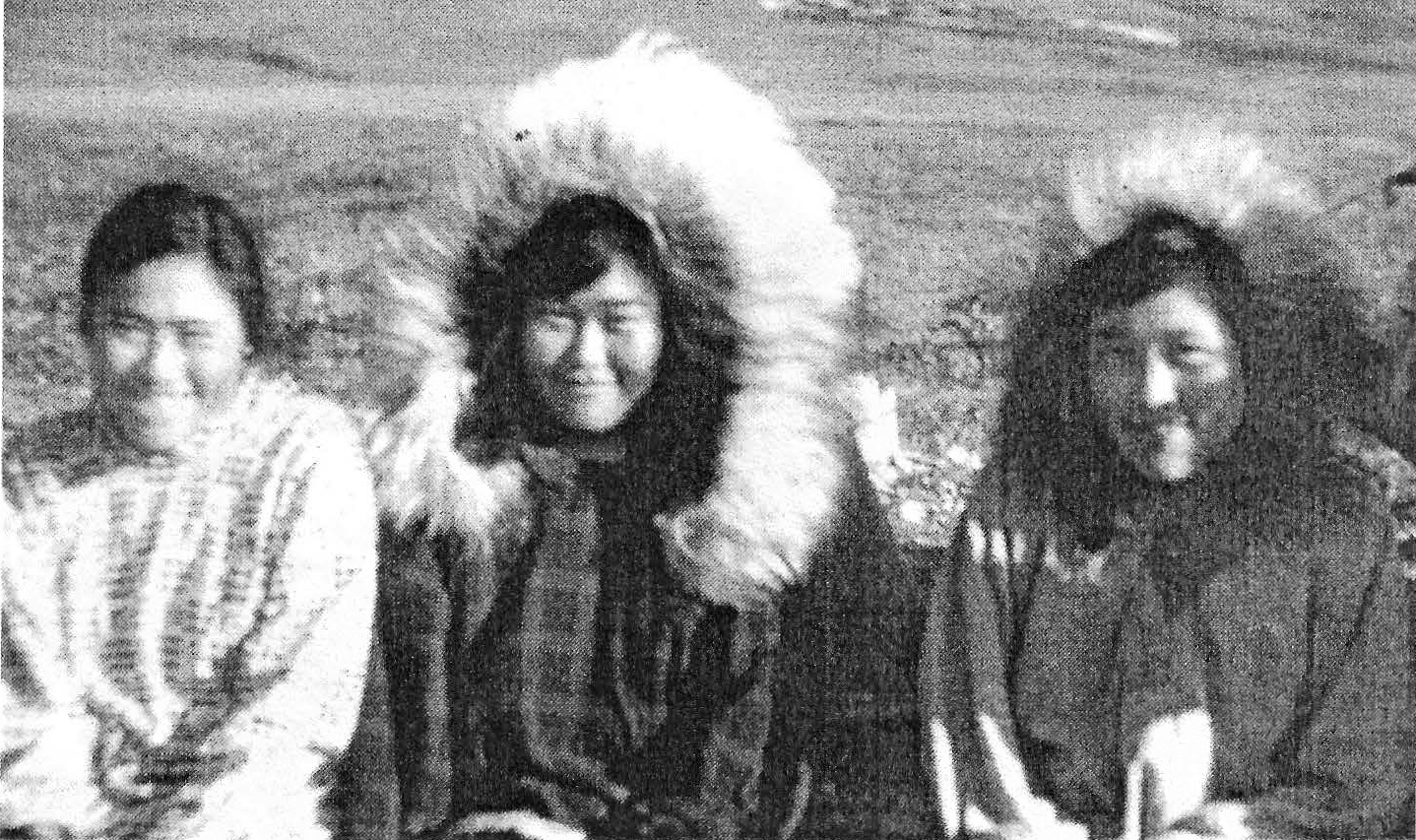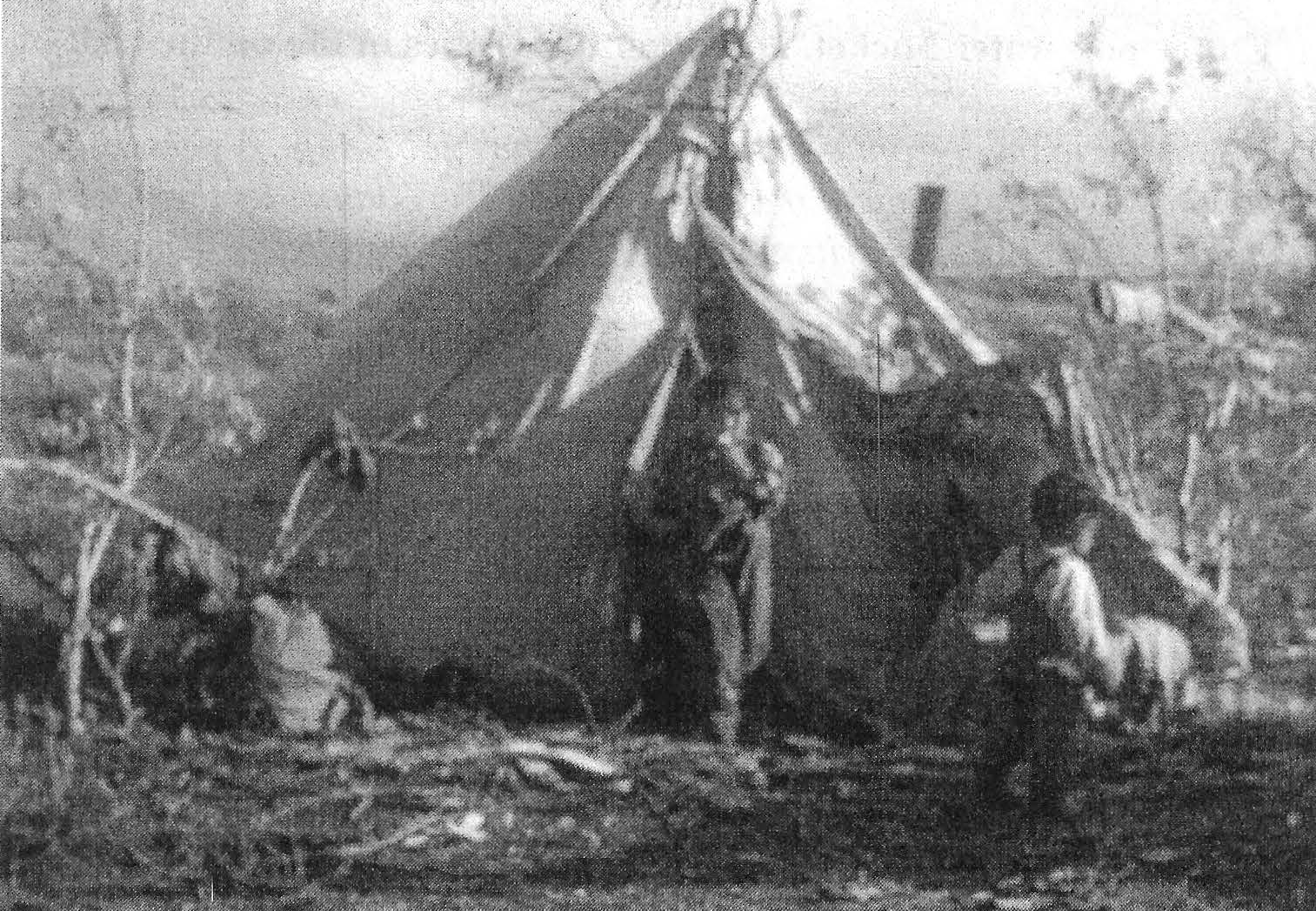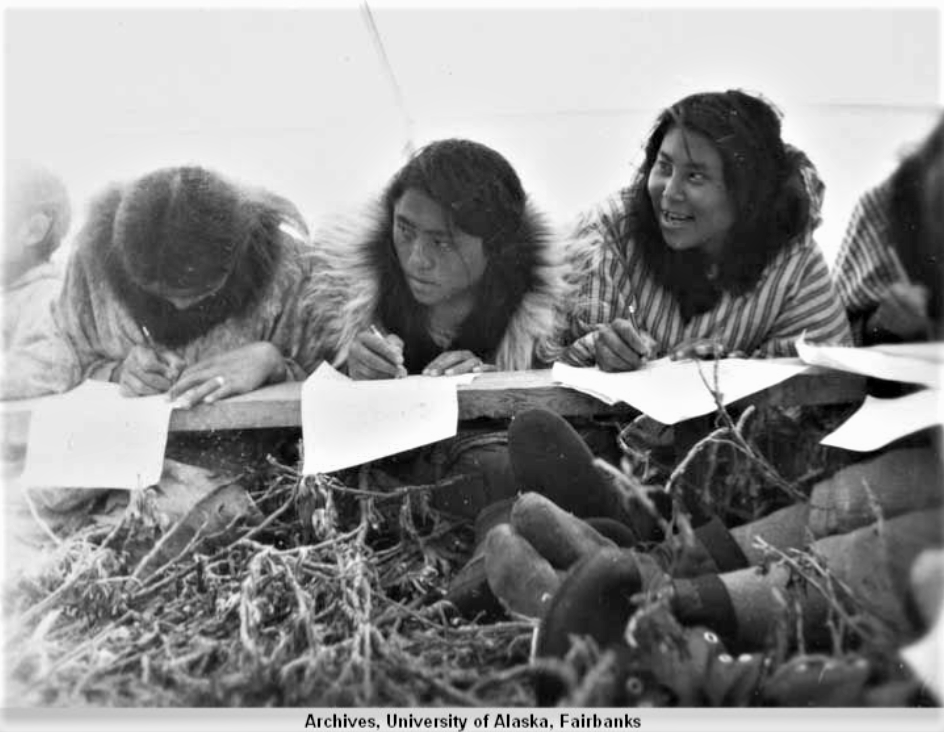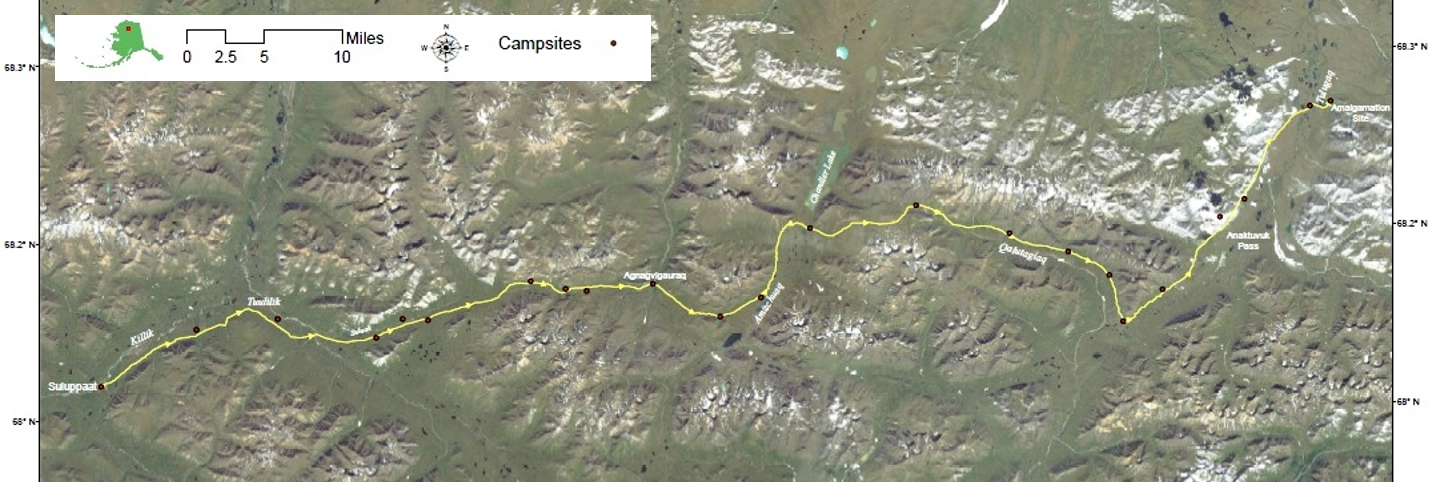Last updated: November 2, 2021
Article
The Long Walk: The Origins of Anaktuvuk Pass

The time is early summer 1949, at Sulupaat, a camp near the mouth of April Creek in the Killik (Killiq) River valley. There, the families of Maptigaq Morry, Inualuuraq Hugo, and Homer Mekiana (Mikiana), their married and unmarried children and grandchildren are prepared to set out on The Long Walk. It would be more than a two week long overland dog-packing trek, as the Killiq families made their way eastward to join another small group of families at Tulugaq Lake, in the Anaktuvuk (Anaqtuuvak) Valley, nearly a hundred miles distant.
“[We were] living at Sullupaat in 1949 at mouth of Suluk River. Mikiana, Inualuraq, Aananiaq, Billy, and us, we all lived there together. And there in the springtime, this sickness, the flu, was moving, and many people died. While we were living there, our older brother Aahaaliq, Peter Morry, and Chris Hugo died. After we buried them, we started out for here, for Anaktuvuk Pass. We began travelling, and we did not stop until we reached Tuulilik. This river, which we call Agiagiaq, was very flooded and could not be crossed in any way, and after the water had receded a little, we crossed it. We travelled, carrying our loads on our backs, using our dogs to help us, they all had loads on their backs. Because at that time, we were not at all wealthy, we did not have any extra gear to load us down…. Along the way, we would get caribou, fresh meat…. The trail that we took has been marked… We reached Uqugmilagat … we travelled through the foothills to Narvagvak…. When we reached Narvagvak, we proceeded to put up camp there. The place where we camped and the trail that we took has been marked. At Narvagvak we found some C rations left behind by the men of the war. And there was nothing wrong with them, so we used them for food. They would discard that food which was wrapped in paper. We also were able to get caribou there at Narvagvak. While we were staying there, Agnaniaq’s woman had a baby. I think it was Martina, the first Martina. And when we reached Qalutagiaq, there were so many caribou there that we stopped to put up camp…. We travelled in this way [with dogs], packing our things. Through Qalutagiaq, going out through this way. We reached the Tulugagmiut down there. Little did we know that we had gone to suffer there. We began to be short on food when we reached Tulukkaq…. We spent the summer there, where Kakinnaaq and Panniaq, Anjmaaq, and Aguk were living… [describes hardships, lack of money, wolf bounty of $30 as only source of cash, meeting Dr. Irving and Bob Paul, archaeologists]. After we spent the summer there in the falltime, we moved here to Anaktuvuk Pass. Mikiana, Noah, us, and also with us was a trader named Patrick Arnold [Pat O’Connell]. He also traded with people at Tulugaq, but he did not handle very large goods. We moved here to Anaktuvuk Pass in that year, 1949.”
-Amos Morry interview by Grant Spearman
Perhaps the best way to capture the essence of what the Long Walk was really like, is to draw upon the memories of Rhoda Tatqavina Morry-Ahgook, a Nunamiut elder, who in the Spring of 1999 recorded her recollections of events some 50 years before.

This is a pivotal moment in recent Nunamiut history, as it heralded the merging of the last remaining, independent Nunamiut families, and the first big step in the more than a decade long process of making the fateful transition from their nomadic way of life to a relatively settled one in a permanent village.
In the story below, Rhoda Ahgook (Aguk), the then teenaged daughter of Maptigaq Morry tells first hand of life on the trail, how people traveled, what they took with them, what the dogs carried, how the animals are cared for, and the many other details of making and breaking camp on a daily basis. It is an interesting and instructive account of a way of life already drifting into memory.
"My father is the first one who wanted to move to Anaqtuuvak Pass. Since the winter months until summer, my father insisted on moving to Anaqtuuvak Pass because Kakinnaa, Anmaalik and Panniaq and their families really wanted my father to be with them. All winter long, my father kept saying that it is imperative for us to move to the Tulugagmiut. So everyone else got the desire too, to dog-pack during the summer months to the Tulugagmiut."

"The reason we could not go sooner is because the flu epidemic is going on. But my father kept talking about going back during the winter. The flu epidemic took two young men, one of which is my father's son.
The only things we had are our bedding, a little bit of coffee, sugar and tea. There is not much else we had. Besides the tea, sugar, and coffee, we also had ammunition. We ran out of all those items except for a small stash of coffee and tea because supplies ran out eventually. Those are what we carried with us.
We had our bedding and mattress that are of caribou skin. The skin of the caribou is turned over in this direction (fur down) to he used as a bottom layer like a pad. Then another caribou skin, a mattress, is placed on top of that, with the hair side up. We carried caribou sleeping bags. My father always made sleeping bags using a number of caribou skins. Two skins are sewn together to make the sleeping bag.
Our parents used to make us sleeping bags so we always slept in caribou skin sleeping bags. The people of Killiq always had sleeping bags made of caribou skin. We are very poor. We did not have factory made blankets that you find in the stores but those made from caribou skins. The cushions and mattress are all made of caribou skin. Those are the only things we had at the time.
The things we carried and took with us, we used to place a skin underneath them so they would not become soaked as we traveled. My older brothers purchased blankets when they went to Kobuk, where the store had received their order of blankets. When my older brother bought me a blanket I was deeply moved and my affection for him grew because he had bought me a blanket.
We use a wood stove all the time. Because we didn't have any other types of stoves. It is the only source from which we kept warm. That's all. My father used to gather rocks sometimes when it is very cold outside to keep the house from getting too cold too soon. He placed the big rocks under the fire that would keep it hot for a long time. Sometimes he used two of them when it is severely cold."

"All the dogs had dog packs. They carried our items and my father would sometimes carry light items such as our sleeping bags. The bedding made of caribou is placed on top of the dog-packs which the dogs carried. The water buckets would go on top of the skins. The stove we had also went on top of the skins. It is a five gallon stove. Sometimes they are two five gallon cans that are joined end to end. When they are lengthened like that it is a long can. Those are our stoves, the five gallon cans.
That is how we carried them when we are dog-packing and traveling. When the five gallon can got used too much it too would get a hole in it from wear and tear. It would get that way from the intense heat coming out of it. My father used to patch them up when that happened though. He would patch them using metal that he hammered around the hole."
In many ways, dog-packs are one of the simplest and most useful items made by the Nunamiut, for in addition to the uses mentioned above, people also found them handy as duffel-bags to store extra clothing, or the pelts of wolves, wolverines, foxes and other fur bearing animals. Other uses included serving as outdoor storage containers during the winter months to hold the choicest caribou bones that would eventually be crushed and boiled to obtain their grease content, or to serve as a sled equipment bag. Hung over the back stanchion of the sled such a bag would hold an assortment of useful gear including rope, extra mittens, socks, boots food and other items.

"All of us used to get everything ready including our father. We had a sourdough starter that is used in the morning. Our sourdough starter had a little bit of water that we carried with us as we dog-packed. Sometimes I carried it but I would tire out from carrying it too much. Every time we camped I used to make sourdough in the morning. Sometimes I made sourdough pancakes the best way I knew how. Right after having breakfast we would start getting ready to go, packing everything for the journey.
Our father did not let us sleep late in the mornings. My father always woke us up. It did not matter if we are sleepy. After getting up I would prepare breakfast, because we had flour. They used to buy us flour. Flour is the only item we had that is store bought. There is no other store bought item that we had. No bread. Not even crackers. Sometimes we would get peanut butter but it never lasted, because there is no store nearby. There is also a one-gallon size of honey that used to last longer. One gallon is enough. Right after we had breakfast our father would get ready to go. Flour is our only white man's food thar we used to make dough. The others are honey and peanut butter in big containers that we had back in those days that we considered our riches.
There is not much else but caribou. When we had only caribou meat for lunch it is usually enough. Caribou, half cooked meat. We did not have seal oil either. We sometimes had caribou fat. Our lunch did not include much else, except tea to drink. That's because we are so poor in those days when we are growing up we are in short supply of a lot of things.
We had tea for lunch. I used to carry our lunch food in a sack. One of the dogs carried the lunch food on his back. When we had caribou meat or fat we used to get them ready to eat at our next stop and loaded them onto the dog-pack for the dog to carry and the dog would carry them. My father did not like to spend too much time looking for food and so they are carefully prepared and put on the dogs to carry. So he would get the lunch food ready and that is what the dog carried. But the dog did not carry too much of a load."

"Each family had their own wall tent that they lived in. Our wall tent is a Tallimalik, it had five panels and is a big rent. A tent with five panels is bigger than a Sisamalik, a tent with four panels. When we are getting ready to come this way, we used to live in a five panel wall tent.
We had a coffee pot and a water bucket and a large cooking pot. Some people who did not have pots improvised and made pots out of five gallon cans. We had a water bucket, a Qattaq, that we considered the closest thing to be our only riches. But it is too big even when you just wanted to make something small, but it is the only thing we had and it still got used.
A person had to be in front of the dogs once they got going. A person always has to be in front and the dogs behind. They do not let the dogs stay in front just in case caribou are spotted. They are always behind except in some cases where the road is smooth and good then there will be one or maybe two dogs in front. The dogs always listen and obey their masters.
When we stopped to take a rest we usually stayed ahout a half an hour before moving on. Because the clock moves fast when you are taking a break from moving on. But when they catch caribou we will stay stopped in one place about an hour or so. They would cut up the caribou for the next meal and for the dogs that would be packed in dog-packs as we moved on. Other people like the Hugo family did the same thing too. Our other relatives also did the same thing. But we never traveled separately. We constantly traveled in one group.
When we stopped to camp we used to build smudge fires to control the mosquitoes around us. When you stop there are always a lot of mosquitoes. There are thousands of mosquitoes flying in the sky above us. We made smudges all the time. When we got caribou we also built a smudge fire to control the insects. When there are a lot of mosquitoes on the days we traveled we did not go without building fires. We used to pick up branches of willow and build a fire when there is sod around us. And when we are leaving we would make sure the fire is completely out before we left it so that it would not spread elsewhere. The fire we built had to be extinguished well. We made sure we completely put the fire out before moving on. Our parents did not like the fire to keep burning and spread."

"We had fly swatters sometimes made of willows. Most of us made our swatters out of the short willows branches with lots of leaves found along the river that are really nice. But my father used a wooden one that he made using the case-gas crate that he whittled into a swatter. We used these case-gas crates as grub boxes.
When we decided to camp for the rest of the day, there are a number of us who quickly set up the tent. My father and Amos quickly pitch up the tent by stretching it out. And pieces of willow are used to make stakes that the ropes are tied to before being staked to the ground to hold the tent up. And rocks are used to push the stake into the ground.
Even if the tent has not been staked I search for willow branches to make a tent floor because I don't like to sleep in a tent without them. Even today I look for willows when I am out camping. It smells very good to have fresh cut willows on the tent floor. My father would set up the stove we had and we would gather up some wood to start the fire in the stove. Because there are three of us we did not waste any time getting things done. We would be very busy when we started to set up camp. When it starts raining outside we would be very busy trying to set up camp as quickly as we could.
I used to feed the dogs all the time myself. I fed the dogs. It's easy to care for the dogs in the summer months. In the winter months they too have to be fed meat that isn't frozen. The dogs have to be fed water. Always giving water to the dogs. We always kept the dog bowls to let the dogs drink water. They made dog bowls out of five gallon cans that are cut through the center of the whole can horizontally.
So we never threw the dog bowls away because we did not have other cans with which to feed them. We had three or four bowls that we took turns when giving the dogs water to drink until every dog is given water. The chores are sometimes a lot of work but we did it anyway. My father did not like the dogs to get thirsty. He used to tell us that dogs are like human beings too. They are not allowed to get thirsty for water. I is the person who always fed the dogs."

George Llano
"We used to tie the troublesome dogs around the willow branches, when there are a lot of mosquitoes flying around. Otherwise we staked sharpened branches of willow to the ground for those who would not try to get loose. We used branches of willow and sharpened them. My father and Amos used to take the two sharpened branches and staked them towards each other when mosquitoes are really bad.
When the dogs did not have tie downs they used to tie a rope to the end of a willow pole and that's how they used to keep the dogs tied down. We use willow dog chains. They call that Qirugaq that is used to tie the dog with. It's made so that it enables the dog to go in circles without getting tangled. Sometimes we even build a smudge fire for the dogs. You have to tie the dogs in just the right way when you are going to build them a fire to control the insects around them."

George Llano
And so it went, day after day for nearly two weeks until the Killiq families finally reached Tulugaq, and a new chapter in their lives began. Although they did not know it at the time, they would never return to the Killiq to stay, and they had now embarked on a journey that that would lead them to settlement of the Village of Anaqtuuvak Pass.
Learn more about
the history of Anaktuvuk Pass
on the Gates of the Arctic website
Tags
- gates of the arctic national park & preserve
- alaska
- alaska native
- alaska native history
- gates of the arctic national park and preserve
- anaktuvuk pass
- brooks range
- indigenous heritage
- native american heritage month
- arctic
- arctic culture
- stories
- traditional knowledge
- people
- places
- native stories
- culture

